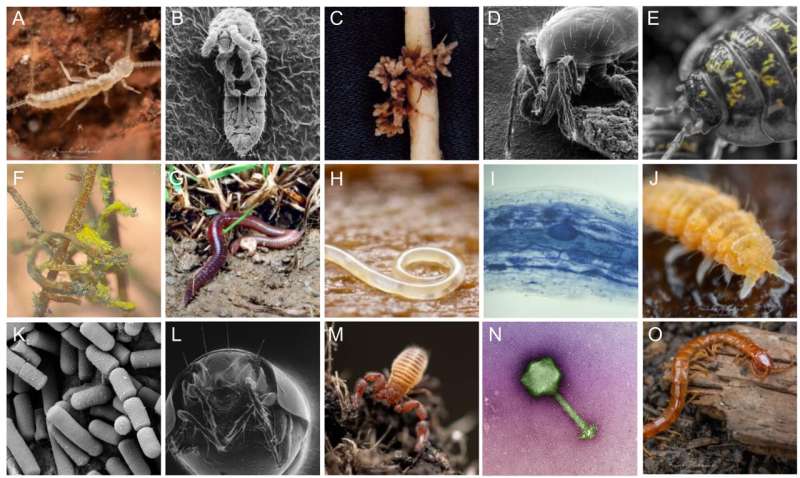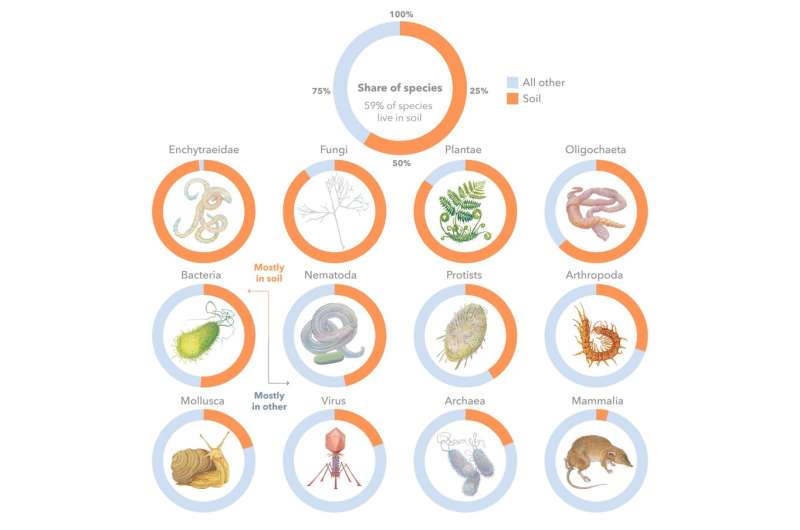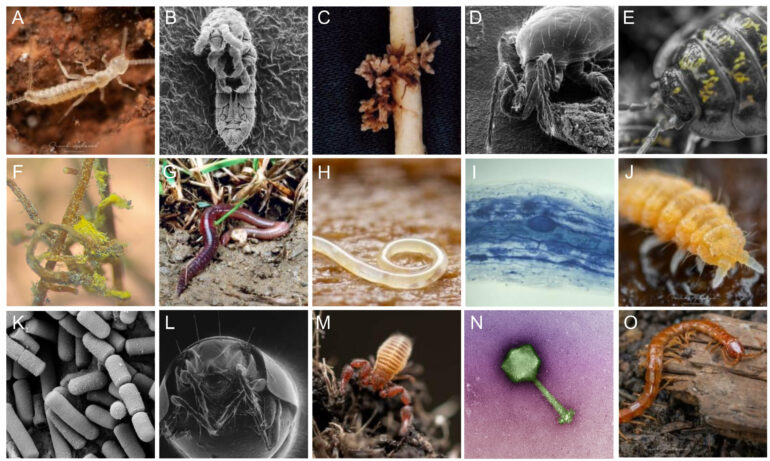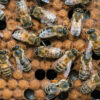by Beate Kittl, Swiss Federal Institute for Forest, Snow and Landscape Research WSL
Coral reefs, the deep sea or the treetops of the rainforests are considered the main hotspots of biodiversity. However, they all trail behind the soils. According to a new study, soils are the most species-rich ecosystems worldwide. Their importance for human nutrition is enormous, and the proportion of soils worldwide that are considered degraded or destroyed is growing steadily. A trio of researchers led by the Swiss Federal Institute for Forest, Snow and Landscape Research WSL has now made the first estimate of global soil biodiversity.
To do this, the researchers from WSL, the University of Zurich and the Agroscope agricultural research station searched the existing scientific literature or re-evaluated existing data sets on species that have been identified in soils. Their results, reported in the journal Proceedings of the National Academy of Sciences, indicate that two-thirds of all species live in the soil. This is more than twice as high as previous estimates of soil species richness. According to those, only 25% of all species live in the soil.
The group with the highest proportion of species living in the soil is fungi—90% of them live there. They are followed by plants and their roots with 86%. Earthworms and mollusks such as snails make up 20%. “However, no one has yet attempted to estimate the diversity of the very small organisms such as bacteria, viruses, archaea, fungi and unicellular organisms,” says the first author, Mark Anthony from WSL. Yet they are crucial for recycling nutrients in the soil, for carbon storage, and they are important as pathogens and partners of trees.

Diversity of the major life forms found in soil. A) bristletail ( F. Ashwood), B) springtail ( H. Conrad), C) nitrogen-fixing bacteria-containing nodules on clover root ( M. van der Heijden), D) predatory mite ( H. Conrad), E) isopod ( F. Ashwood), F) scots pine root colonized by ectomycorrhizal fungi (yellow) ( M. Anthony), G) earthworm ( G.Brändle), H) nematode ( A. Murray), I) corn root colonized by arbuscular mycorrhizal fungi (blue) ( F. Bender), J) springtail ( F. Ashwood), K) a common soil bacterium Bacillus (Creative Commons Attribution-Share license, photo by M. Das Murtey and P. Ramasamy), L) horned mite ( H. Conrad), M), pseudoscorpion ( F. Ashwood), N) phage infecting a soil bacterium ( T. de Carvalho), O) centipede. © Ashwood
Promote better protection of soils
Since the data on soil diversity is extremely patchy—especially in the global South—the results of the study show huge ranges in some cases. For bacteria, for example, the mean value is 40% of species living in the soil—but the range extends from 25% to 88%. The uncertainties are also enormous for viruses, which are mainly studied as human pathogens. Accordingly, the authors are bracing themselves for some criticism of their methods and conclusions. “Our work is a first but important attempt to estimate what proportion of global biodiversity lives in the soil,” says Anthony.

Graphical overview of the share of species living in soil. Doughnuts reflect the percentage of species in soil versus all other ecosystems combined (e.g., marine, freshwater, built environment, host organisms such as humans). The larger doughnut on top shows the total share of species, and smaller doughnuts show individual shares for the most speciose and well-known groups ordered from greatest to least specialized in soil. © Michael Dandley
The goal, he says, is to provide the basis for much-needed decisions to protect soils and their creatures worldwide. “Soils are under enormous pressure, whether from agricultural intensification, climate change, invasive species and much more,” Anthony points out. “Our study shows that the diversity in soils is great and correspondingly important, so they should be given much more consideration in conservation.”
More information:
Mark A. Anthony et al, Enumerating soil biodiversity, Proceedings of the National Academy of Sciences (2023). DOI: 10.1073/pnas.2304663120
Provided by
Swiss Federal Institute for Forest, Snow and Landscape Research WSL
Citation:
Two-thirds of the world’s biodiversity lives in the soil (2023, August 8)



